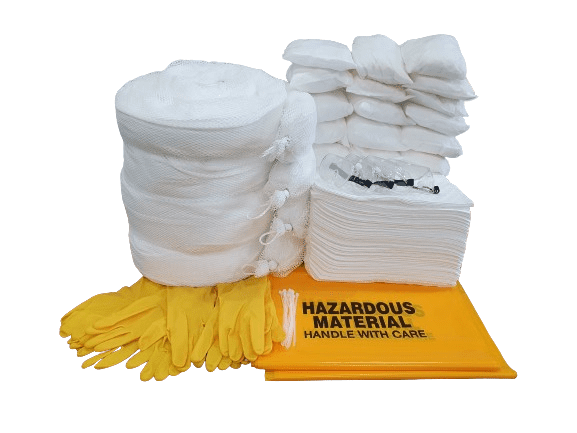Marine spills, whether caused by fuel leaks, oil discharges, or other hazardous substances, can have severe consequences for businesses operating in aquatic environments. From shipping companies to marinas and offshore operations, having the right marine spill kit is essential to ensure swift and effective response. These kits are specifically designed to address spills in water environments, with tools like marine booms playing a critical role in containment and cleanup.
However, choosing the right marine spill kit for your business requires careful consideration of several factors. In this guide, we’ll explore how to select the best marine spill kit to meet your needs and ensure compliance, safety, and environmental protection.
1. Assess the Types of Spills You’re Likely to Encounter
- Oil and Fuel Spills:
If your business involves handling oil, diesel, or fuel, such as shipping, fishing, or recreational boating, a marine spill kit tailored for hydrocarbons is essential. These kits include absorbents that repel water while soaking up oil and fuel effectively. - Chemical Spills:
For industries dealing with hazardous chemicals, such as offshore drilling or industrial ports, specialised marine spill kits with chemical-resistant components may be required. - General Purpose Spills:
Businesses with low-risk operations, such as marinas or small boat operators, may benefit from general purpose marine spill kits that handle a variety of spills.
Understanding the types of spills you’re likely to encounter ensures you choose a kit with the appropriate absorbents and tools.
2. Evaluate the Size and Scale of Potential Spills
- Small-Scale Spills:
For minor spills, such as fuel leaks from recreational boats or small vessels, compact marine spill kits are sufficient. These kits are lightweight and portable, making them ideal for businesses with limited space or smaller-scale operations. - Large-Scale Spills:
If your business operates in high-risk environments, such as cargo ships, tankers, or offshore platforms, invest in a more comprehensive marine spill kit. These kits include larger quantities of absorbents, marine booms, and deployment tools to handle significant spills effectively.
Assessing the scale of potential spills helps ensure you select a kit that can manage the volume of incidents you’re likely to face.
3. Consider the Role of Marine Booms
- Containment Booms:
These floating barriers are essential for containing spills on water surfaces, preventing them from spreading to sensitive areas like shorelines or habitats. Look for booms made from durable, weather-resistant materials that can withstand harsh marine conditions. - Absorbent Booms:
Combining containment and absorption functions, absorbent booms are ideal for addressing oil and fuel spills directly on the water surface. - Diversion Booms:
These tools redirect spills away from critical areas, such as water intakes or ecosystems, minimising environmental damage.
The type and quality of marine booms included in the kit are crucial factors to consider, as they play a central role in spill response.
4. Prioritise Portability and Accessibility
- Compact Kits for Mobility:
For businesses operating in remote or hard-to-reach areas, such as offshore rigs or small vessels, choose a portable marine spill kit that can be easily transported to spill sites. - Waterproof Storage Containers:
Ensure the kit is stored in a waterproof, corrosion-resistant container to protect components from saltwater exposure and harsh weather conditions. - Quick Access During Emergencies:
Store the kit in a visible and accessible location, such as near fueling stations, docks, or onboard vessels, ensuring it’s ready for immediate use during emergencies.
Portability and accessibility ensure that your team can respond quickly and effectively when spills occur.
5. Ensure Compliance with Regulations
- Industry Standards:
Many marine industries are subject to strict regulations that require businesses to have spill management plans and equipment in place. Non-compliance can result in hefty fines, legal liabilities, and reputational damage. - Certified Components:
Choose marine spill kits with components that meet industry standards and regulations, ensuring they are suitable for use in aquatic environments. - Documentation and Reporting:
Some kits come with instruction manuals and documentation that streamline reporting and compliance processes. Look for kits that include clear guidelines for use and disposal.
Ensuring compliance not only protects your business from penalties but also demonstrates your commitment to safety and environmental responsibility.
6. Focus on Durability and Weather Resistance
- Harsh Marine Conditions:
Marine environments can be challenging, with rough waters, strong currents, and unpredictable weather. Choose a spill kit with durable components that can withstand these conditions. - Corrosion-Resistant Materials:
Tools like deployment anchors, ropes, and connectors should be made from corrosion-resistant materials to ensure longevity and reliability. - UV-Resistant Absorbents:
Absorbents and booms should be UV-resistant to prevent degradation from prolonged sun exposure.
Durability and weather resistance ensure that your marine spill kit remains effective and ready for use over time.
7. Set a Budget and Prioritise Essentials
- Affordable Options:
For small businesses or low-risk environments, affordable marine spill kits provide essential tools for managing minor spills without exceeding budgets. - Comprehensive Solutions:
For high-risk environments, investing in a more robust marine spill kit with advanced features, such as marine booms and skimmers, is worth the additional cost. - Cost vs. Value:
While cheaper kits may save money upfront, prioritise quality and functionality to avoid inadequate cleanup during emergencies.
Setting a budget and prioritising essentials ensures you get the best value for your investment.
8. Train Your Team and Maintain Readiness
- Training Programs:
Conduct regular training sessions to ensure employees know how to use the marine spill kit properly. Include drills to familiarise everyone with the process and build confidence. - Regular Inspections:
Check your marine spill kit periodically to ensure all components are intact and ready for use. Replace used or expired items immediately to maintain readiness. - Emergency Protocols:
Develop clear protocols for responding to spills, including containment strategies, cleanup steps, and communication procedures. Ensure everyone knows their role during an emergency.
Training and maintenance ensure that your team is prepared to respond effectively during a spill incident.
9. Explore Customisation Options
- Tailored Solutions:
Some marine spill kits can be customised to include additional tools or absorbents based on unique industry needs. For example, offshore drilling operations may require specialised chemical absorbents, while shipping companies may need larger quantities of marine booms. - Scalable Kits:
Choose a kit that can be scaled up or down depending on the size of your operation and the risks involved. - Eco-Friendly Materials:
Opt for kits that include biodegradable absorbents and sustainable materials to align with global environmental goals.
Customisation ensures that your marine spill kit meets the specific needs of your business and environment.
10. Consider the Long-Term Benefits
- Protecting Your Reputation:
A well-prepared marine spill kit demonstrates your commitment to safety, sustainability, and environmental responsibility, enhancing your business’s reputation. - Reducing Cleanup Costs:
Swift response reduces the scale of cleanup efforts, saving time and resources. - Minimising Environmental Impact:
By containing spills quickly, marine spill kits prevent pollutants from spreading into sensitive ecosystems, protecting marine life and habitats.
Investing in the right marine spill kit not only protects your business but also contributes to a safer and more sustainable future.
Conclusion
Choosing the right marine spill kit for your business in Brisbane and Perth involves careful consideration of several factors, including the types of spills, spill size, portability, durability, and regulatory requirements. By assessing your specific needs and risks, you can select a spill kit that ensures safety, compliance, and peace of mind. Whether you opt for a compact kit for small-scale operations or a comprehensive solution with advanced marine booms, having the right tools on hand is essential for managing spills responsibly. With proper training, regular inspections, and a focus on quality, your business in Brisbane and Perth can confidently face any marine spill-related challenge while minimising risks and costs.





